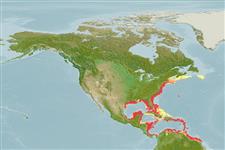>
Syngnathiformes (Pipefishes and seahorses) >
Syngnathidae (Pipefishes and seahorses) > Syngnathinae
Etymology: Hippocampus: Greek, ippos = horse + Greek,kampe = curvature (Ref. 45335).
Environment: milieu / climate zone / depth range / distribution range
Ecologia
marino associati a barriera corallina; non migratori; distribuzione batimetrica 0 - 100 m (Ref. 128812). Subtropical; 10°C - 27°C (Ref. 36630); 50°N - 32°S, 98°W - 32°W (Ref. 52034)
Western Atlantic: Canada (off Scotian shelf) to Brazil; including countries of the Gulf of Mexico and the West Indies. A southern form that may prove to be a separate species is known from Rio de Janeiro, Brazil and questionably from Suriname.
Length at first maturity / Size / Peso / Age
Maturity: Lm 6.3 range ? - ? cm
Max length : 19.0 cm OT maschio/sesso non determinato; (Ref. 30915); Età massima riportata: 1.00 anni (Ref. 1285)
Short description
Morfologia | Morfometria
Spine dorsali (totale): 0; Raggi dorsali molli (totale): 16-20.
Generally in coastal waters; often around man-made structures (Ref. 26938). Usually attached to gorgonians or seagrasses but may occur in floating Sargassum or swimming freely in midwater (Ref. 9710). Those that live in Sargassum usually have bony protuberances and fleshy tabs that may serve as camouflage. Has been reared in captivity (Ref. 35420, 35422). Move into deeper waters during winter (Ref. 36630). Feeds by sucking in small organisms, using its long face as a pipette (Ref. 26938); like small crustaceans (Ref. 27549). Ovoviviparous (Ref. 205). The male carries the eggs in a brood pouch which is found under the tail (Ref. 205). Length type refers to Height (= from top of coronet to the tip of straightened tail).
Incubates eggs in an external marsupium. Gestation period 20-21 days but varies with water temperature (Ref. 30915).
Lourie, S.A., R.A. Pollom and S.J. Foster, 2016. A global revision of the seahorses Hippocampus Rafinesque 1810 (Actinopterygii: Syngnathiformes): taxonomy and biogeography with recommendations for further research. Zootaxa 4146(1):1-66. (Ref. 115213)
IUCN Red List Status (Ref. 130435)
Threat to humans
Harmless
Human uses
Pesca: scarso interesse commerciale; Acquario: Commerciale
Informazioni ulteriori
BibliografiaAcquacolturaProfilo di acquacolturaVarietàGeneticaElectrophoresesEreditarietàMalattieElaborazioneNutrientsMass conversion
Strumenti
Special reports
Download XML
Fonti Internet
Estimates based on models
Preferred temperature (Ref.
123201): 12.1 - 27, mean 24 °C (based on 144 cells).
Phylogenetic diversity index (Ref.
82804): PD
50 = 0.5000 [Uniqueness, from 0.5 = low to 2.0 = high].
Bayesian length-weight: a=0.00447 (0.00177 - 0.01127), b=3.00 (2.78 - 3.22), in cm total length, based on LWR estimates for this (Sub)family-body shape (Ref.
93245).
Trophic level (Ref.
69278): 3.5 ±0.51 se; based on food items.
Generation time: 3.2 ( na - na) years. Estimated as median ln(3)/K based on 1
growth studies.
Resilienza (Ref.
120179): Alto, tempo minimo di raddoppiamento della popolazione meno di 15 mesi (K=0.34; tmax=1; Fec=1,552).
Fishing Vulnerability (Ref.
59153): Low to moderate vulnerability (31 of 100).
Nutrients (Ref.
124155): Calcium = 47.1 [22.2, 120.5] mg/100g; Iron = 0.62 [0.33, 1.15] mg/100g; Protein = 18.5 [17.4, 19.7] %; Omega3 = 0.186 [0.102, 0.333] g/100g; Selenium = 15.1 [6.8, 35.8] μg/100g; VitaminA = 78.1 [23.5, 255.2] μg/100g; Zinc = 0.985 [0.614, 1.530] mg/100g (wet weight);
